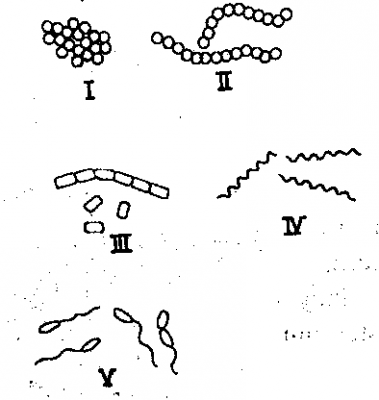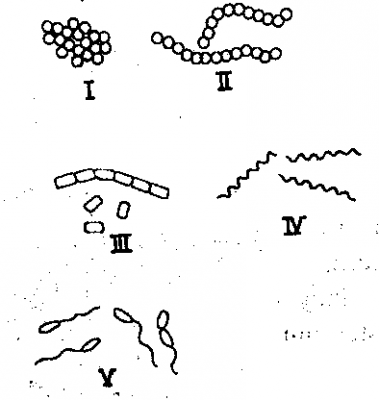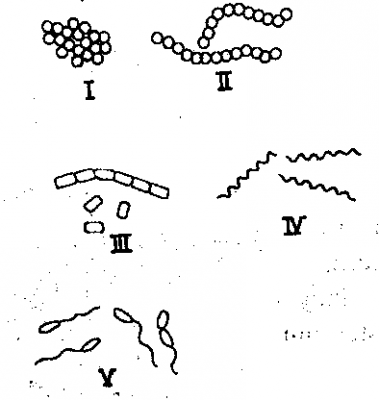The diagrams below are illustrations of forms in which a particular group of organisms exist. Study them and answer the question.

in which of the illustrated forms does the organism that causes cholera exist?
III
II
IV
V
Correct answer is D

V.
Vibrio: These are comma-shaped bacteria. They are curved rods and are often found in aquatic environments. Vibrio cholerae is an example, responsible for causing cholera.
The diagrams below are illustrations of forms in which a particular group of organisms exist. Study them and answer the question.

Which group of organisms is illustrated?
protozoa
viruses
fungi
bacteria
Correct answer is D
No explanation has been provided for this answer.
The food substance that would produce the highest amount of energy is
protein
amino acid
fat
glucose
Correct answer is C
The food substance that would produce the highest amount of energy is fat.
Fat is the most energy-dense macronutrient, providing 9 calories per gram. On the other hand, both carbohydrates (including glucose) and proteins provide 4 calories per gram. While amino acids are the building blocks of proteins, they are not a direct source of energy like fat and carbohydrates.
Which of the following activities is against the conservation of natural resources?
Contour ploughing
afforestation
establishment of game reserves
deforestation
Correct answer is C
Deforestation: Deforestation is the opposite of afforestation. It involves the clearing or removal of forests or trees from an area. Deforestation leads to the loss of valuable natural resources like timber, biodiversity, soil fertility, and water regulation. It disrupts ecosystems, accelerates soil erosion, and releases stored carbon dioxide, contributing to climate change. Deforestation is detrimental to the conservation of natural resources and has serious environmental consequences.
Organisms that feed on dead, decaying tissues of other organisms are known as
saprophytes
autotrophs
parasites
heterotrophs
Correct answer is A
Organisms that feed on dead, decaying tissues of other organisms are known as "saprophytes." Saprophytes, also known as saprotrophs or decomposers, are organisms that obtain their nutrition by feeding on dead, decaying organic matter (detritus) from other organisms.
The ability of organisms to maintain a constant internal environment is known as
diuresis
plasmolysis
endosmosis
homeostasis
Correct answer is D
The ability of organisms to maintain a constant internal environment is known as "homeostasis." Homeostasis is a fundamental biological concept that refers to the ability of living organisms to maintain a stable and relatively constant internal environment despite changes in the external environment.
The type of nutrition in which organisms take solid organic materials into their body is
parasitic
holozoic
saprophytic
symbiotic
Correct answer is B
Holozoic nutrition is a type of nutrition in which organisms consume solid organic materials. This is the type of nutrition seen in most animals, where food is ingested and then broken down through digestion. This is different from symbiotic (where two organisms live together and benefit from each other), saprophytic (where organisms feed on dead and decaying matter), and parasitic (where one organism benefits at the expense of another) nutrition.
The organ which is sensitive to light in Euglena is the
gullet
chloroplast
eye spot
contractile vacuole
flagellum
Correct answer is C
No explanation has been provided for this answer.
The process by which the amount of water and solutes in the blood is controlled is known as
hemolysis
diffusion
turgidity
osmoregulation
Correct answer is D
No explanation has been provided for this answer.
Diagram J is a protease while diagrams K, L, M, and N are food substances. Study them and answer this question.

Protease J would react with the particular illustrated substance because enzymes?
K
L
M
N
Correct answer is B
No explanation has been provided for this answer.
WAEC Subjects
Aptitude Tests
Latest Jobs
Information and Communication Manager at Nigerian Breweries Plc
Area Sales Manager at Airtel Nigeria
State Business Manager at Airtel Nigeria
Regional Technical Officer at Airtel Nigeria
Business Manager at Airtel Nigeria
Contract Administrator at Robert Walters
Import & Export Manager at Kerildbert Holdings Limited
JV Account Payable Officer at WTS Energy